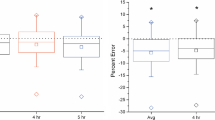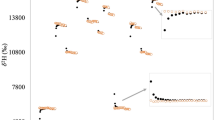Summary
The purpose of the present study was to validate the13C bicarbonate method (13C-M) and the doubly labeled water method (DLWM) for the estimation of the CO2 production R(CO2) in goats as a ruminant model. Indirect calorimetry was chosen as the reference method. Studies were carried out in 2 male African dwarf goats at 3 different developing stages (age: 5, 10, and 14 months, body mass: 14.6, 20.3, and 21.7 kg). Animals were fed a balanced feed 14 days before and during the studies. The isotope tracers (4 mg/kg NaH13CO3, 120 mg/kg2H2O, and 75 mg/kg H2 18O; 99 At.-%) were simultaneously given as a single pulse injection into the jugular vein. Thereafter, the animals were kept for 8 days in two respiration chambers (volume of chamber: 2.85 m3, air flow rate: 25 1 / min) for the estimation of CO2 production and O2 consumption. For the determination of R(CO2) using the13C-M samples of exhaled breath were drawn from the respiration chambers. The13C enrichment and CO2 concentration of breath samples were measured by means of an infrared isotope analyzer. In order to determine R(CO2) by means of the DLWM, blood serum was used. The2H and18O enrichments were measured by an isotope ratio mass spectrometer. Urine samples were collected over 24 h to quantify renal water losses.
The R(CO2) was calculated by means of the13C-M using the area under the13C enrichment-time curve. The determination of R(CO2) by means of the DLWM was based on the slopes of the2H and18O disappearance curves and the body water pool obtained from the zero time intercept of the isotope curves.
The values of R(CO2) resulting from the13C-M were found to be comparable with those from the calorimetric measurement. Smaller (not statistically significant) values of R(CO2) - 92% from13C-M and 87% from DLWM - compared to the indirect calorimetry could indicate the incorporation of13C and2H into metabolites other than CO2 and H2O, respectively. The body water contents calculated from the zero time intercepts of the2H and18O disappearence curves amounted to 66% and 63%, respectively. The body water content was found to be not related to the age of animals. The renal water loss was calculated to be 35% of the total water loss (0.76 l/d).
Zusammenfassung
Zweck der vorliegenden Untersuchung war die Validierung der13C-Bicarbonat-Methode (13C-M) und der doppeltmarkierten Wassermethode (DLWM) zur Bestimmung der CO2-Produktion R(CO2) bei Ziegen als Wiederkäuermodell. Die indirekte Kalorimetrie war als Referenzmethode ausgewählt worden. Die Untersuchungen wurden an 2 Afrikanischen Zwergziegen bei 3 unterschiedlichen Entwicklungsstadien (Alter: 5, 10 und 14 Monate, Körpermasse: 14,6, 20,3 und 21,7 kg) durchgeführt. Die Tiere wurden 14 Tage vor und während der Untersuchung bilanziert gefüttert. Die Isotopentracer (4 mg/kg NaH13CO3, 120 mg/kg2H2O and 75 mg/kg H2 18O; 99 At.-%) wurden simultan als einmalige impulsförmige Dosis in die Vena jugularis injiziert. Danach befanden sich die Tiere für 8 Tage in zwei Respirationskammern (Kammervolumen: 2,85 m3, Luftdurchsatz: 25 l/ min), um die CO2-Produktion und den O2-Verbrauch zu bestimmen. Für die Bestimmung von R(CO2) mit Hilfe der13C-M wurden Proben der Ausatemluft aus den Respirationskammern gezogen. Die Messung der13C-Anreicherung und der CO2-Konzentration der Atemproben erfolgte mittels eines Infrarot-Analysators. Für die Bestimmung von R(CO2) mittels der DLWM wurde Blutserum verwendet. Die2H- und18O-Anreicherungen wurden massenspektrometrisch gemessen. Urinproben wurden zur Quantifizierung des renalen Harnverlusts über 24h gesammelt. R(CO2) wurde mittcls der13C-M unter Verwendung der Fläche unter13C-Anreicherung-Zeit-Kurve berechnet. Die Bestimmung von R(CO2) mittels der DLWM basierte auf den Anstiegen der2H- und18O-Kurven und dem Körperwasser-Pool. Die Werte von R(CO2) aus der13C-M war vergleichbar mit denen aus kalorimetrischen Messungen. Die im Vergleich zur indirekten Kalorimetrie kleineren (nicht statistisch signifikant) Werte von R(CO2) — 92% aus13C-M und 87% aus DLWM — deuten auf die Inkorporation von13C und2H in andere Metaboliten als CO2 und H2O hin. Die Körperwasser-Pools (bezogen auf die Körpermasse), berechnet aus den Ordinatenabschnitten der2H- und18O-Kurven (bei t=0), betrugen 66% bzw. 63%. Die Körperwasser-Pools zeigten keine Altersabhängigkeit. Der renale Wasserverlust wurde zu 35% des totalen Wasserverlusts (0,76 1 / d) berechnet.
Similar content being viewed by others
References
Coward WA, Cole TJ (1991) The doubly labeled water method for the measurement of energy expenditure in humans: risks and benefits. In: New techniques in nutritional Research. Whitehead RG, Prentice A (eds) Academic Press, New York, NY, pp 139–176
Elia M (1991) Estimation of short-term energy expenditure by the labeled bicarbonate method. In: New techniques in nutritional Research. Whitehead RG, Prentice A (eds) Academic Press, New York, NY, pp 207–227
Elia M, Fuller NJ, Murgatroyd PR (1992) Measurement of bicarbonate turnover in humans: applicability to estimation of energy expenditure. Am J Physiol 263:E676-E687
El-Khoury AE, Sanchez M, Fukagawa NK, Gleason RE, Young VR (1994) Similar 24-h pattern and rate of carbon dioxide production, by indirect calorimetry vs. stable isotope dilution, in healthy adults under standardized metabolic conditions. J Nutr 124:1615–1627
Haggarty P (1991) Potential of the doubly labeled water method for estimating heat production in farm animals. J Agricul Sci 117:141–148
International Dietary Energy Consultancy Group (1990): International Dietary Energy Consultancy Group. The doubly-labeled water method for measuring energy expenditure: Technical recommendations for use in humans. Cambridge: IDECG/IAEA, Vienna, pp 1–294
Junghans P, Derno M, Jentsch W, Voigt J, Scholze H, Göbel D (1995) Investigation of the energy and the protein metabolism in goats using13C and15N tracer techniques. Workshop „Breath Diagnostics“, 12. December 1995, Rostock
Junghans P, Hotz G, Strauch G, Hubald J, Faust H, Häcker R (1992) Assessment of the energy metabolism in man using a new stable13C,15N isotope method. 14th Congress of the European Society of Parenteral and Enteral Nutrition, Vienna, 7.–9. August 1992. Proceedings: Clin Nutrition 11(Suppl.):77–78
Sahlu T, Hart SP, Klein PD, Jacquemet N, Carneiro H (1992) Application of13CO2 measurements to the estimation of energy expenditure in goats. Can J Anim Sci 72:245–252
Schoeller DA, Ravussin E, Schutz Y, Acheson KJ, Baertschi P, Jequier E (1986) Energy expenditure by doubly labeled water validation in humans and proposed calculation. Am J Physiol 250:R823-R830
Spear ML, Darmaun D, Sager BK, Parsons WR, Haymond MW (1995) Use of [13C]bicarbonate infusion for measurement of CO2 production. Am J Physiol 268:E1123–1127
Author information
Authors and Affiliations
Rights and permissions
About this article
Cite this article
Junghans, P., Derno, M., Gehre, M. et al. Calorimetric validation of13C bicarbonate and doubly labeled water method for determining the energy expenditure in goats. Z Ernährungswiss 36, 268–272 (1997). https://doi.org/10.1007/BF01617796
Published:
Issue Date:
DOI: https://doi.org/10.1007/BF01617796
Key words
- Stable isotopes
- 13C
- 2H
- 18O
- doubly labeled water method
- carbon dioxide production
- energy expenditure
- indirect calorimetry
- goat
- ruminant




